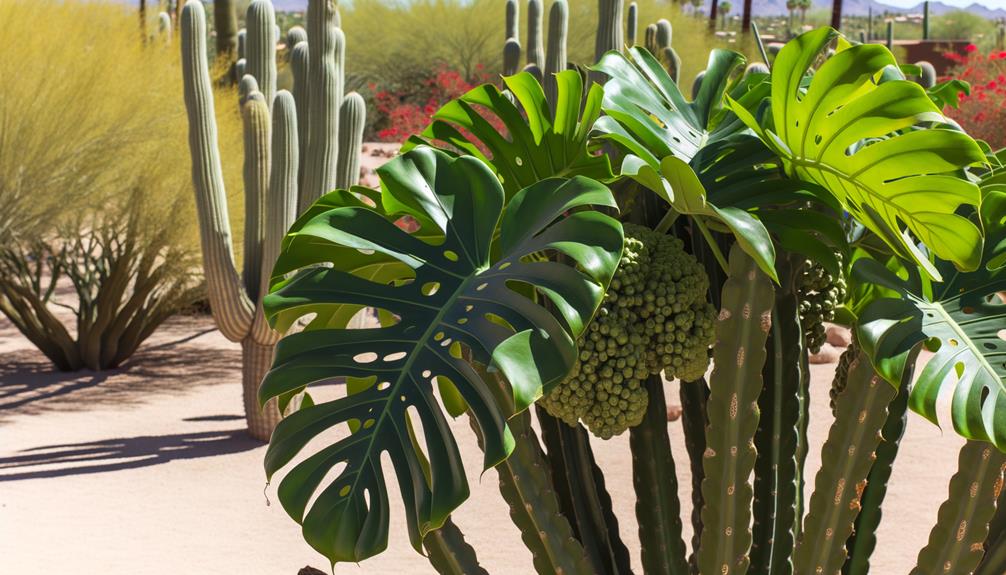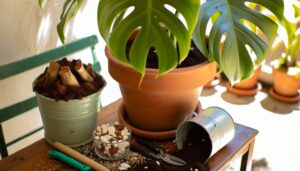Growing Monstera Deliciosa Fruit in Phoenix
To cultivate Monstera Deliciosa fruit in Phoenix, monitor temperatures with a dependable thermometer and keep them above 50°F. Use a humidifier to maintain 60-80% humidity.
Plant in well-draining, organic-rich soil with coco coir, perlite, pine bark, and compost. Water when the top inch of soil is dry and ensure proper drainage to prevent root rot.
Provide 6-8 hours of bright, indirect sunlight, using shade cloths and grow lights if necessary. Rotate the plant weekly for even light distribution.
Harvest when scales lift, and ripen fruit in a paper bag. Further essentials await in the detailed cultivation guide.

Key Takeaways
- Maintain humidity between 60-80% with a humidifier to support Monstera deliciosa growth in Phoenix's dry climate.
- Ensure temperatures consistently remain above 50°F by monitoring daily fluctuations with a reliable thermometer.
- Use a well-draining, organic-rich soil mix with coco coir, perlite, pine bark, and compost for optimal growth.
- Place the plant in bright, indirect sunlight for 6-8 hours daily and use grow lights if natural light is insufficient.
- Water when the top inch of soil is dry, ensuring pots have drainage holes to prevent root rot and fungal issues.
Climate Considerations
Growing Monstera deliciosa fruit in Phoenix demands careful attention to the local climate, as the plant thrives in high humidity and temperatures that don't typically drop below 50°F. Start by monitoring the daily temperature fluctuations using a reliable thermometer.
You'll need to ensure consistent warmth, especially during winter months. Implement a humidifier in your growing area to maintain humidity levels between 60-80%. Placing the plant in a well-ventilated space helps prevent fungal issues due to trapped moisture. Additionally, protect your Monstera from direct sunlight by using a shade cloth, as excessive sun can scorch the leaves.
Regularly check weather forecasts to anticipate extreme conditions, and adjust your growing setup accordingly. These steps will help you create an ideal microclimate for your Monstera deliciosa.
Choosing the Right Soil
Selecting the correct soil for your Monstera deliciosa is crucial to guarantee proper drainage, aeration, and nutrient availability. Opt for a well-draining, organic-rich soil mix to replicate the plant's natural tropical environment. A balanced mix ensures that your Monstera's roots receive sufficient oxygen and nutrients.
To create an ideal soil mix, include:
- Coco coir: Enhances moisture retention and aeration.
- Perlite: Improves drainage and prevents soil compaction.
- Pine bark: Adds organic matter and improves structure.
- Compost: Provides essential nutrients and promotes microbial activity.
- Horticultural charcoal: Assists in absorbing impurities and enhancing root health.
Watering Techniques
Consistently monitor the soil moisture levels to secure your Monstera deliciosa receives adequate hydration without becoming waterlogged. Utilize a soil moisture meter to measure the water content accurately.
Aim for soil that's moist but not soggy, typically re-watering when the top inch is dry. Make sure the pot has drainage holes to prevent water accumulation, which could lead to root rot. Water deeply, allowing excess to drain out, securing even distribution.
In Phoenix's arid climate, you may need to water more frequently, especially during hot months. Use room-temperature, dechlorinated water to avoid shocking the roots. Mulching can help retain moisture and regulate soil temperature.
Regularly adjust your watering schedule based on seasonal changes and plant growth stages.
Sunlight Management
To maximize growth, place your Monstera deliciosa in a location where it receives bright, indirect sunlight for at least 6 to 8 hours each day. Direct sunlight can scorch the leaves, so it's essential to filter the light. Use sheer curtains or place the plant near a north or east-facing window. If natural light is insufficient, consider using grow lights to supplement.
- Light Intensity: Measure using a light meter to guarantee ideal levels.
- Seasonal Adjustments: Modify plant placement as sunlight angles change.
- Rotation: Rotate the plant weekly for even light distribution.
- Shade Cloths: Employ these outdoors to diffuse strong sunlight.
- Monitoring: Observe for signs of light stress, such as yellowing leaves.
Proper sunlight management ensures robust growth and healthy foliage.
Harvesting the Fruit
You'll know it's time to harvest Monstera deliciosa fruit when the scales on the fruit start to lift and show a creamy color underneath.
Carefully detach the fruit from the plant using sterilized pruning shears to prevent any contamination.
Place the harvested fruit in a paper bag at room temperature to allow the ripening process to continue.
Monitor the fruit daily; once the scales begin to fall off naturally, it's ready for consumption.
Be cautious—eating unripe sections can cause irritation due to calcium oxalate crystals.
Wear gloves and use a knife to separate the edible parts from the remaining scales.
Enjoy the fruit's sweet, pineapple-like flavor, ensuring all sections are fully ripe before consumption.
Conclusion
Cultivating Monstera deliciosa fruit in Phoenix mirrors the meticulous care depicted in 'The Secret Garden.'
You've learned to harmonize soil composition, hydration methods, and sunlight exposure. By adhering to these precise techniques, you'll reveal the botanical mysteries of this tropical plant.
Your journey from preparation to harvest embodies the scientific rigor akin to a seasoned horticulturist. Continue this diligent stewardship, and you'll turn your desert garden into an oasis of exotic fruit.






